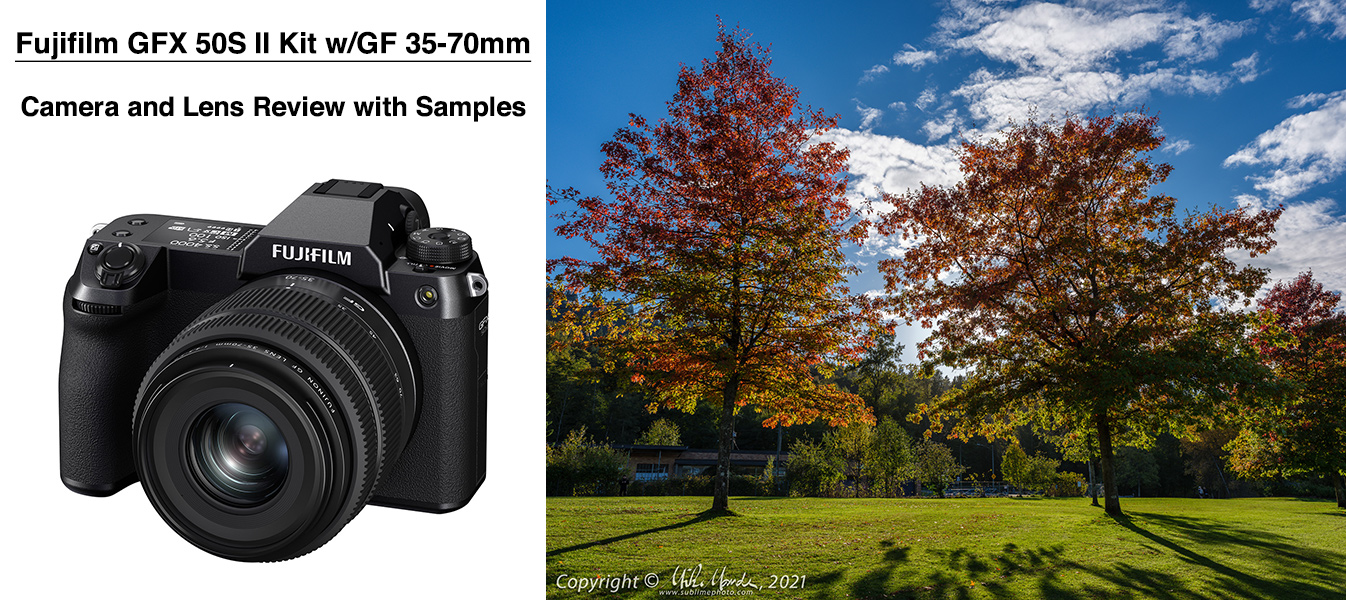Last month, Fujifilm announced the latest in their GFX series of medium format digital cameras, which has been designated the GFX 50S II, as well as a few news lenses. You can read about it in our October newsletter here: Beau Photo Newsletter – October 2021
I recently had the chance to briefly try out a preproduction GFX 50S II and the new very affordable kit lens, the GF 35-70mm f/4.5-5.6 WR zoom. Overall, I must say I am most impressed, especially with the lens. I was honestly not expecting much from a medium format lens that only costs $625 when bundled with the body, but it performed far better than I had expected it to. Sure, it has some (automatically corrected) barrel distortion at the wider end of its zoom range, but it is not bad and corner sharpness seems very good even after software correction. In all fairness, I mainly shot the lens at f/8 to f/11, since most were outdoor landscape style images, and at those f-stops the lens was quite sharp across the frame.
Here is a link to an image gallery with samples: Fujifilm GFX 50S II with GF 35-70mm Tests
Wide open, the center sharpness was certainly good, but I have no tests to see how the edges or corners fare at the widest f-stops. Being a slow f-stop zoom, this lens is not ideal for maximizing your subject isolation, and its bokeh is a bit nervous when out of focus parts of your shot are closer to the camera too, but for such a small, light and inexpensive lens, I feel that any minor image quality issues are forgivable. Sure, the Fujinon GF prime lenses will generally get you sharper results, but they are also larger, heavier and much more expensive too. While I haven’t shot them side by side, I even feel that the little 35-70mm would compare favourably overall to the much larger GF 45-100mm f/4.
The GF 35-70mm balances extremely well on the 50S II and feels well made, despite its low price. It does have the WR (weather resistant) designation as well. I do wish personally that Fujifilm had included an aperture ring, but I suppose that was a cost saving measure. You need to set the lens aperture using a control wheel on the camera body, which due to the GFX 50S II’s design, feels quite natural.
There were no surprises with the camera itself. It handled just like a GFX 100S with slightly slower AF. The IBIS worked well but it didn’t seem to be quite as effective as the IBIS in the 100S was when I tested that camera. A probable explanation for that is that the inexpensive 35-70mm might have a slightly smaller image circle than some of the primes I had used on the GFX 100S, and Fujifilm tunes their IBIS to only deflect the sensor far enough to stay within the good quality portion of a lens’ image circle. In other words, with a smaller image circle, you would also get fewer stops of effective IBIS. For example, on the Fujifilm X-H1, the IBIS rating ranged from over 5-stops with many prime lenses to only 2.5 stops with the 10-24mm ultra-wide zoom. I do not have an IBIS reference chart for GF lenses though, so this is only speculation on my part for now.
If you don’t need a 100MP image, don’t need your medium format camera to do good 4K video, or simply don’t have the budget for the GFX 100S (which is $2,800 more), then the GFX 50S II makes for a very compelling camera with some great features at a very good price point, especially when bundled with the kit GF 35- 70mm zoom! If you have any questions about this new body and lens, or would just like to order one, contact us and we can help you out! In fact, as of this posting we have both the body and the kit in stock to sell.
To see my more detailed review of the GFX 100S (with the same body), see here: Tested! GFX 100S Body
Check our listings for the Fujifilm GFX 50S body or kit, the GF 35-70mm lens, and the GFX 100S body on our website by clicking on their respective names.




